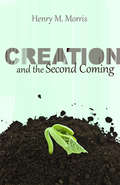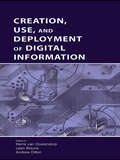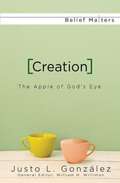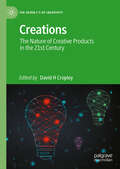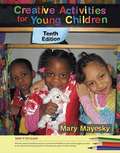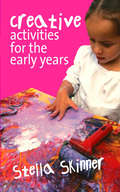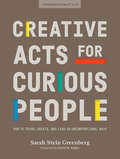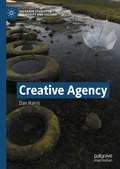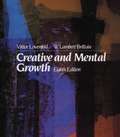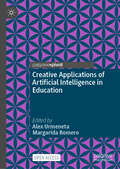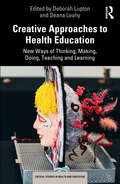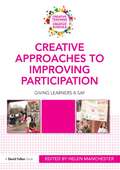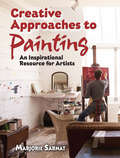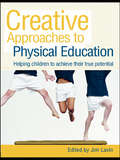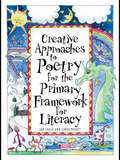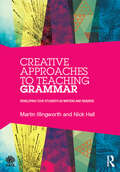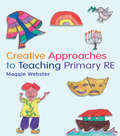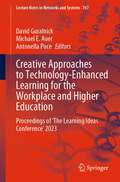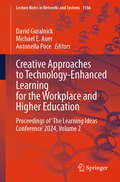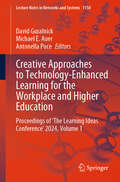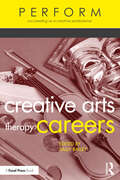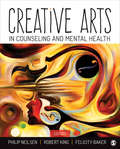- Table View
- List View
Creation and the Second Coming
by Dr Henry M. MorrisPossibly the only book of its kind, Creation and the Second Coming captivates the reader by linking our origins with our destiny. Blending biblical stories like Noah andJesus teaching His disciples, Dr. Henry Morris weaves an intriguing resource for prophecy and creationism buffs.
Creation, Use, and Deployment of Digital Information
by Herre Van Oostendorp Leen Breure Andrew DillonThe aim of this book is to present results of scientific research on how digital information should be designed and how artifacts or systems containing digital content should maximize usability, and to explain how context can influence the nature and effectiveness of digital communication. Using a philosophical, cognitive, and technical standpoint, the book covers the issue of what digital information actually is. The text also presents research outcomes from the perspective of research in information science--broadly construed--a term now used to cover a range of theoretical and practical approaches.Creation, Use, and Deployment of Digital Information is broken down into three parts:*Part I presents information on how electronic documents can be realized--the complexities, alternatives, functions, and restrictions are treated here.*Part II discusses how human beings process information and how technical solutions can satisfy human restrictions.*Part III treats the context in which digital information processing and deployment takes place.The book has much to offer to academics in many disciplines, including science, the arts, psychology, education, and the information and computing sciences.
Creation: The Apple of God's Eye (Belief Matters)
by Justo L. GonzalezHow and why God loves us—God's good creationThis book will talk about the doctrine of creation and invite us to look closely at who God is and who we are in relationship with God. As people of faith, we believe that our gracious God created all there is, but does that also mean that God also created evil? How does creation jive with what scientists are telling us about the origin of the universe? What does the doctrine of creation tell us about what we call "the creation," that is, the world, its value, purpose, etc? How does understanding the world as God’s creation teach us about our role in creation care?The Bible tells us that God created the heavens and earth, but does that deny the science of the Big Bang? What does believing that God is the Creator say about how God loves, redeems, and sustains us today or does creation say something only about the past? What about the "new creation''? Does this have anything to do with the old creation? Does it mean simply that God is so tired of the rebelliousness of creation that it seems best to erase the present one and start anew? Or is there a connection between the two?What does the doctrine of creation say about us? Aren’t we created in God’s image and aren’t we part of the good creation of a loving God? If so, why is there evil and rebelliousness in us? Where does our ill-will, our desire to do evil, come from? Is there freedom of the will or are all things preordained by God? Just how detailed is God’s plan for us?While no one author can deal with all these questions, this book will help us begin the conversation and gain new understanding of how the doctrine of creation can help us address these very human and timeless questions.Series Description:Belief Matters: How to Love God with Your Mind is a series of books written by widely recognized authors who will help readers think more clearly about their faith and better understand their beliefs, so that they can live more faithfully. These books will also help readers become aware of thoughtful resources and conceptual frames of reference that not only will deepen their faith, but also help them better understand what we say and do in Church. Conversational in tone, these books are reflections on major theological topics and are suitable for a 4-session individual or group study. The intent of the series is to help readers feel as though they are sitting, having coffee as authors share their "take" and show that by thinking more clearly about the faith, persons can love God more fully, live with confidence, and change the world.
Creations: The Nature of Creative Products in the 21st Century (The Seven C’s of Creativity)
by David H CropleyThis edited book explores creative products (i.e. Creations) as part of the seven C's of creativity framework. Through nine chapters, leading scholars in the field explore five different domains (education, crime/terrorism, music, science and engineering) addressing the nature of the creations in each given domain, and the criteria by which creations in that domain are judged. Drawing together key, underpinning concepts from the science of creativity, the book delves into the history of creativity research applied to products to then explore new concepts that are impacting on research, especially the role of artificial intelligence in supporting the development and assessment of creative products.
Creative Acrylic Landscapes
by Wendy JelbertWendy Jelbert shares her expertise in working with acrylics and in creating beautiful, convincing landscapes. There is information on what materials to buy, how to use sketches and photographs, how to look at landscape shapes and how to use tone and composition to good effect. Wendy demonstrates a variety of acrylic techniques and explains elements of the landscape such as foregrounds, distances and skies. There are six beautiful step-by-step demonstrations with clear photographs and instructions for readers to follow.
Creative Activities For Young Children (Tenth Edition)
by Mary MayeskyCREATIVE ACTIVITIES FOR YOUNG CHILDREN, 10th Edition, is a terrific book filled with fun, creative, and easy-to implement activities for young children. You'll be encouraged to exercise your own creativity, as well as learn how to help young children do the same. Hundreds of activities, up-to-date research, recipes, finger plays, information on how to select children's books, and more make this book an invaluable resource for you and others planning to work creatively with children across the curriculum--and one you'll want to keep for use throughout your professional career.
Creative Activities for the Early Years
by Stella M. Skinner′An excellent resource for all those working with young children... jam-packed with exciting, inspirational activities that encourage young children to nurture their creativity and imagination while helping practitioners to facilitate what children do naturally... It is a book that celebrates and encourages original thought and action to support learning through exploration and investigation, recognising that creativity is about representing one′s own image and not reproducing someone else′s′ - Early Years Educator ′[I]nspirational... This book is easy to read, refreshing and exciting, and I would recommend it to all those working with young children. It is also useful for students, clearly articulating the reasons for providing well-organised child-initiated creative opportunities rather than adult-directed activities′ - Nursery World It is an interesting and informative manual aimed at those who work with children in the 3-5 years age range, and is therefore most suited to anyone in a Pre-School or Day Nursery setting, and could also be valuable to a Reception Teacher...over all, I found this to be a very useful book′. - National Childminding Association Packed full of exciting ideas and powerful visual aids, this book will help those working with young children to encourage and nurture their creativity and imagination. The book takes examples of what has worked in an early years setting, and transfers these inspirational activities onto the page. The book includes: " practical activities in Art, Dance and Music and ideas on how to link them together; " advice on how to make the most of music, lighting, space and nursery resources; " showing how the work supports the Foundation Stage Curriculum; " ideas for cross-curricular work; " suggestions for recording children′s progress; " advice on how to choose materials, and a list of specialist suppliers. Everyone involved in working with young children should read this book. Nursery practitioners, early years teachers, Sure Start workers, play workers and Children′s Centre staff will find it an invaluable resource. It is also useful for specialist staff in hospitals and other areas of health.
Creative Acts for Curious People: How to Think, Create, and Lead in Unconventional Ways (Stanford d.school Library)
by Sarah Stein Greenberg Stanford d.schoolWINNER OF THE PORCHLIGHT BUSINESS BOOK AWARD • &“A delightful, compelling book that offers a dazzling array of practical, thoughtful exercises designed to spark creativity, help solve problems, foster connection, and make our lives better.&”—Gretchen Rubin, New York Times bestselling author and host of the Happier podcast In an era of ambiguous, messy problems—as well as extraordinary opportunities for positive change—it&’s vital to have both an inquisitive mind and the ability to act with intention. Creative Acts for Curious People is filled with ways to build those skills with resilience, care, and confidence. At Stanford University&’s world-renowned Hasso Plattner Institute of Design, aka &“the d.school,&” students and faculty, experts and seekers bring together diverse perspectives to tackle ambitious projects; this book contains the experiences designed to help them do it. A provocative and highly visual companion, it&’s a definitive resource for people who aim to draw on their curiosity and creativity in the face of uncertainty. Teeming with ideas about discovery, learning, and leading the way through unknown creative territory, Creative Acts for Curious People includes memorable stories and more than eighty innovative exercises. Curated by executive director Sarah Stein Greenberg, after being honed in the classrooms of the d.school, these exercises originated in some of the world&’s most inventive and unconventional minds, including those of d.school and IDEO founder David M. Kelley, ReadyMade magazine founder Grace Hawthorne, innovative choreographer Aleta Hayes, Google chief innovation evangelist Frederik G. Pferdt, and many more. To bring fresh approaches to any challenge–world changing or close to home–you can draw on exercises such as Expert Eyes to hone observation skills, How to Talk to Strangers to foster understanding, and Designing Tools for Teams to build creative leadership. The activities are at once lighthearted, surprising, tough, and impactful–and reveal how the hidden dynamics of design can drive more vibrant ways of making, feeling, exploring, experimenting, and collaborating at work and in life. This book will help you develop the behaviors and deepen the mindsets that can turn your curiosity into ideas, and your ideas into action.
Creative Agency (Palgrave Studies in Creativity and Culture)
by Dan HarrisThis book offers a socio-cultural examination of contemporary creativity studies. Drawing heavily on posthumanist, new materialist and affective theoretics, the author argues in favour of an expansive and sustainable approach to creativity which contributes to an emergent ‘creativity studies’ inter-discipline. It seeks to establish a broader consideration of creativity in socio-culture, that extends beyond, or indeed refutes, the narrowing aperture of entrepreneurship and innovation as synonyms for creativity in economic, cultural and educational contexts and discourses. Drawing on multiple case studies of creative relational and creative ecological empirical research, this book integrates a concern for personal, planetary and geo-political collaboration, as an antidote for ‘innovation for innovation’s sake’.
Creative And Mental Growth
by Viktor Lowenfeld W. BrittainChildren are the essence of this book, but more than that, they are the essence of society. Creative and intellectual growth are the basis of any educational system, and it is the hope that this book can contribute to an understanding of the importance of this area so as to make the education of children a joyful and meaningful experience.
Creative Applications of Artificial Intelligence in Education (Palgrave Studies in Creativity and Culture)
by Margarida Romero Alex UrmenetaThis open access book explores the synergy between AI and education, highlighting its potential impact on pedagogical practices. It navigates the evolving landscape of AI-powered educational technologies and suggests practical ways to personalise instruction, nurture human-AI co-creativity, and transform the learning experience. Spanning from primary to higher education, this short and engaging volume proposes concrete examples of how educational stakeholders can be empowered in their AI literacy to foster creativity, inspire critical thinking, and promote problem-solving by embracing AI as a tool for expansive learning. Structured in three parts, the book starts developing the creative engagement perspective for learning and teaching to then present practical applications of AI in K-12 and higher education, covering different fields (teacher education, professional education, business education) as well as different types of AI supported tools (games, chatbots, and AI assisted assessment). It also delves into the ethical considerations, policy implications, and the central role educators play in harnessing the power of an AI informed educational experience.
Creative Approaches to Health Education: New Ways of Thinking, Making, Doing, Teaching and Learning (Critical Studies in Health and Education)
by Deborah Lupton Deana LeahyThis book shows how creative methods, drawing on innovative arts-based and design-based approaches, can be employed in health education contexts. It takes a very broad view of ‘health education’, considering it as applying not only in school settings but across the lifespan, and as including physical education and sexuality education as well as public health campaigns, health activist initiatives and programmes designed for training educators and health professionals. The chapters outline a series of case studies contributed by leaders in the field, describing projects using a wide variety of creative methods conducted in a variety of global contexts. These include a rich constellation of arts-based and design-based methods and artefacts: sculptures, dance, walking and other somatic movement, diaries, paintings, drawings, zines, poems and other creative writing, body maps, collages, stories, films, photographs, theatre performances, soundscapes, potions, rock gardens, brainstorming, debates, secret ballots, murals and graffiti walls. There are no rules or guidelines outlined in these contributions about ‘how to do’ creative approaches to health education. However, the methods in the case studies the authors describe are explained in detail so that they can be adopted or re-invented in other contexts. More importantly, these contributions provide inspiration. They demonstrate what can be done in the field of health education (however it is defined) to go beyond the often stultifying and conventional boundaries it has set for itself. Creative Approaches to Health Education demonstrates that creative approaches can be used to inspire those working and teaching in health education and their publics to think and do otherwise as well as advance health education research and pedagogies into new, exciting and provocative directions. It will be of interest to postgraduate students and researchers in education and health-related fields who want to explore and experiment with creative methods and craftivism in applied inquiry.
Creative Approaches to Improving Participation: Giving learners a say (Creative Teaching/Creative Schools)
by Helen ManchesterIntroducing creativity to the classroom is a concern for teachers, governments and future employers around the world, and there has been a drive to make experiences at school more exciting, relevant, challenging and dynamic for all young people, ensuring they leave education able to contribute to the global creative economy. Creative Approaches to Improving Participation examines ways in which young people have been given a creative voice in the classroom, and have actively participated in their own learning, transforming classrooms, curricula, assessment structures and teaching practices. Promoting reflection on current ‘student-teacher-school’ relationships, the contributions within this book illustrate how the active engagement of students can lead to greater motivation, self-reliance and risk-taking, skills essential for a successful post-school career. Through an exploration of students’ current inclusion in school life, this book provides: a study of key issues and debates surrounding student participation ideas for increasing student participation and ‘personalised learning' case studies from a range of creative learning projects with analysis of their achievements guidance on the creation of active pedagogies practical suggestions for reflective practice. A practical, accessible guide to creatively increasing students’ participation, this book is valuable reading for all practising and trainee teachers, school managers and school leaders working with young people in education.
Creative Approaches to Painting: An Inspirational Resource for Artists (Dover Art Instruction)
by Marjorie SarnatDiscover how to find and keep your inspiration and how to advance your visual style with this collection of more than 200 imaginative ideas for painting. Students, teachers, and professionals alike can benefit from this guide, which suggests clever and resourceful concepts for paintings and shows how to identify sources of inspiration. In addition to tips on ways to organize ideas, it proposes unusual methods with innovative materials and offers advice, answers, and techniques for artists of every style. <P><P> Award-winning artist and author Marjorie Sarnat encourages artists to make this book their own by highlighting entries, tagging pages, and jotting down their own ideas in the margins and on the note pages provided. This immensely useful volume will complement any studio or classroom reference library and provide a reading companion for visual artists. The practical and imaginative suggestions offer artists an opportunity to do more — and to do it better.
Creative Approaches to Physical Education: Helping Children to Achieve their True Potential
by Jim LavinCreative Approaches to Physical Education provides guidance on how to develop innovative new approaches to the delivery of each area of the National Curriculum for PE at Key Stages 2 and 3. The ideas have all been successfully developed in schools where every child has been encouraged to find success and to express themselves in new ways that surprise and delight teachers. Pupils feel ownership of their learning and pride in their achievements, fostering interest, creativity and motivation. Ideal for non-specialist and specialist PE teachers and trainee teachers alike, this book: explores the PE curriculum in a much wider sense than traditional approaches allow covers the key areas of physical education such as games, dance and gymnastics inspires us to look afresh at how we can exploit the learning potential of the outdoors shows how children use skills to express themselves creatively gives innovative suggestions for the use of ICT in PE teaching to encourage independent, personalised leaning examines how physical education can be linked with other subjects in a creative way. Childhood obesity is a growing concern and there are worries that young people have few purposeful leisure interests. This book offers teachers and all those who work with young people alternative approaches and activities that allow young people to express their creative side through physical activity and discover active healthy interests that will last a lifetime.
Creative Approaches to Poetry for the Primary Framework for Literacy
by Jan Foale Linda PagettCreative Approaches to Poetry for the Primary Framework for Literacy supports teachers in planning, teaching and, most importantly, enjoying poetry with their pupils. With an emphasis on creative, cross curricular approaches the authors explore tried and tested methods of teaching poetry in an engaging and comprehensive manner. A carefully considered range of poems has been included in order to expand children’s repertoires in a variety of poetic forms. Chapters cover: how to develop a range of creative approaches to teaching poetry, involving visualisation, drama, choral speaking, performance, discussion and writing how to engage children from a variety of backgrounds and abilities in experiencing poetry in its many forms integrating the teaching of poetry with all other areas of the curriculum including ICT and citizenship effectively linking all work to the KS1 poetry units of the renewed Primary National Framework for Literacy an innovative model that takes children on a journey beginning before they meet the poem through to becoming poets themselves. This accessible and user-friendly book includes informative case studies, photographs and children’s work to demonstrate alternative routes to working with poetry. It will prove an invaluable resource for all primary teachers seeking to employ progressive and effective strategies in the teaching of poetry.
Creative Approaches to Teaching Grammar: Developing your students as writers and readers (National Association for the Teaching of English (NATE))
by Nick Hall Martin IllingworthCreative Approaches to Teaching Grammar is an easily accessible, practical guide full of ideas to support teachers in making the learning of grammar a natural part of developing their students as writers and as readers. Written for those teaching years 5,6,7 and 8, the authors' approach concentrates on the individual needs of students rather than of a year group as a whole. Split into two main sections, the first looks at creative ways of exploring grammar and includes more than forty ideas that can be implemented into the classroom. This section can be used as a quick resource or the whole sequence can be followed to ensure students are investigating, exploring and having fun with grammar. The second section includes an extensive glossary of terms to develop a full understanding of grammar which can be used to audit your own competences and highlight areas for further development. Creative ideas explored include: Being silly with grammar Favourite words Exploding sentences Writing for real audiences New punctuation marks and emoticons Sorting out confusing words Broadening active vocabulary Top ten spelling tips Flexing your vocabulary brain Redundancy in language Creative Approaches to Teaching Grammar is a truly practical guide that is a must read for anyone teaching grammar to years 5,6,7 and 8. With plenty of ideas to implement into the classroom it encourages students to take ownership of their own learning and progress.
Creative Approaches to Teaching Primary RE
by Maggie WebsterAs an increasingly significant aspect of primary teaching, Creative Approaches to Teaching Primary RE is the essential companion to help bring creativity to life in the classroom. The text begins with a discussion of creative education and the value of Religious Education, moving on to reflect on the cross-curricular nature of the subject, exploring ways of introducing creativity to the classroom, through the medium of Religious Education. Each chapter provides ideas and activities demonstrating how pedagogy and theory can be applied in practice within a school setting. The inclusion of case studies will help you consider how to develop creative approaches in all curriculum areas. This book invites you to ask questions such as:· What is Creative Education?· Why should RE be included in the ever-changing curriculum?· How can I use Religious Education to generate a more creative environment in the classroom?
Creative Approaches to Technology-Enhanced Learning for the Workplace and Higher Education: Proceedings of ‘The Learning Ideas Conference’ 2023 (Lecture Notes in Networks and Systems #767)
by Antonella Poce Michael E. Auer David GuralnickNew technologies provide us with new opportunities to create new learning experiences, leveraging research from a variety of disciplines along with imagination and creativity. The Learning Ideas Conference was created to bring researchers, practitioners, and others together to discuss, innovate, and create.The Learning Ideas Conference 2023 was the 16th annual conference and was held as a hybrid event. The conference took place from June 14–16, 2023., both in New York and online, and included a special track: The ALICE (Adaptive Learning via Interactive, Collaborative and Emotional Approaches) Special Track.Topics covered in this book include among others: online learning methodologies, diversity and inclusion in learning, case studies in university and corporate settings, new technologies in learning (such as virtual reality, augmented reality, holograms, and artificial intelligence), adaptive learning, and project-based learning.The papers included in this book are of interest to researchers in pedagogy and learning theory, university faculty members and administrators, learning and development specialists, user experience designers, and others.
Creative Approaches to Technology-Enhanced Learning for the Workplace and Higher Education: Proceedings of ‘The Learning Ideas Conference’ 2024, Volume 2 (Lecture Notes in Networks and Systems #1166)
by Antonella Poce Michael E. Auer David GuralnickNew technologies provide us with new opportunities to create new learning experiences, leveraging research from a variety of disciplines along with imagination and creativity. The Learning Ideas Conference was created to bring researchers, practitioners, and others together to discuss, innovate, and create. The Learning Ideas Conference 2024 was the 17th annual conference and was held as a hybrid event. The conference took place from June 12th-14th, 2024, both in New York and online, and included the ALICE (Adaptive Learning via Interactive, Collaborative and Emotional Approaches) Special Track, and a Special Session from IGIP, the International Society for Engineering Pedagogy. Topics covered in this book include, among others: uses of artificial intelligence in learning, online learning methodologies, case studies in university and corporate settings, new technologies in learning (such as, along with AI, virtual reality, augmented reality, holograms, and more), adaptive learning, and project-based learning. The papers included in this book may be of interest to researchers in pedagogy and learning theory, university faculty members and administrators, learning and development specialists, user experience designers, and others.
Creative Approaches to Technology-Enhanced Learning for the Workplace and Higher Education: Proceedings of ‘The Learning Ideas Conference’ 2024. Volume 1 (Lecture Notes in Networks and Systems #1150)
by Antonella Poce Michael E. Auer David GuralnickNew technologies provide us with new opportunities to create new learning experiences, leveraging research from a variety of disciplines along with imagination and creativity. The Learning Ideas Conference was created to bring researchers, practitioners, and others together to discuss, innovate, and create. The Learning Ideas Conference 2024 was the 17th annual conference and was held as a hybrid event. The conference took place from June 12th–14th, 2024, both in New York and online, and included the ALICE (Adaptive Learning via Interactive, Collaborative and Emotional Approaches) Special Track, and a Special Session from IGIP, the International Society for Engineering Pedagogy. Topics covered in this book include, among others: uses of artificial intelligence in learning, online learning methodologies, case studies in university and corporate settings, new technologies in learning (such as, along with AI, virtual reality, augmented reality, holograms, and more), adaptive learning, and project-based learning. The papers included in this book may be of interest to researchers in pedagogy and learning theory, university faculty members and administrators, learning and development specialists, user experience designers, and others.
Creative Arts Therapy Careers: Succeeding as a Creative Professional (ISSN)
by Sally BaileyCreative Arts Therapy Careers is a collection of essays written by and interviews with registered drama therapists, dance/movement therapists, music therapists, art therapists, poetry therapists, and expressive arts therapists.The book sheds light on the fascinating yet little-known field of the creative arts therapies – psychotherapy approaches which allow clients to use creativity and artistic expression to explore their lives, solve their problems, make meaning, and heal from their traumas. Featuring stories of educators in each of the six fields and at different stages of their career, it outlines the steps one needs to take in order to find training in one of the creative arts therapies and explores the healing aspects of the arts, where creative arts therapists work, who they work with, and how they use the arts in therapy. Contributors to this book provide a wealth of practical information, including ways to find opportunities to work with at-risk populations in order to gain experience with the arts as healing tools; choosing the right graduate school for further study; the difference between registration, certification, and licensure; and the differences between a career in a medical, mental health, educational, correctional, or service institution.This book illuminates creative arts therapy career possibilities for undergraduate and graduate students studying acting, directing, playwriting, creative writing, visual arts, theatre design, dance, and music. It is also an excellent resource for instructors offering a course to prepare arts students of all kinds for the professional world.
Creative Arts Therapy Careers: Succeeding as a Creative Professional (PERFORM)
by Sally BaileyCreative Arts Therapy Careers is a collection of essays written by and interviews with registered drama therapists, dance/movement therapists, music therapists, art therapists, poetry therapists, and expressive arts therapists. The book sheds light on the fascinating yet little-known field of the creative arts therapies – psychotherapy approaches which allow clients to use creativity and artistic expression to explore their lives, solve their problems, make meaning, and heal from their traumas. Featuring stories of educators in each of the six fields and at different stages of their career, it outlines the steps one needs to take in order to find training in one of the creative arts therapies and explores the healing aspects of the arts, where creative arts therapists work, who they work with, and how they use the arts in therapy. Contributors to this book provide a wealth of practical information, including ways to find opportunities to work with at-risk populations in order to gain experience with the arts as healing tools; choosing the right graduate school for further study; the difference between registration, certification, and licensure; and the differences between a career in a medical, mental health, educational, correctional, or service institution. This book illuminates creative arts therapy career possibilities for undergraduate and graduate students studying acting, directing, playwriting, creative writing, visual arts, theatre design, dance, and music. It is also an excellent resource for instructors offering a course to prepare arts students of all kinds for the professional world.
Creative Arts in Counseling and Mental Health
by Felicity Baker Philip Neilsen Robert KingDrawing on new paradigms and evidence-based discoveries in neuroscience, narrative psychology, and creativity theory, this text explores the beneficial role of expressive arts within a recovery perspective. A framework of practice principles for the visual arts, creative writing, music, drama, dance, and digital storytelling is addressed across a number of settings and populations, providing readers with an accessible overview of techniques taught in counseling programs in the U.S. and abroad.
Creative Arts in Counseling and Mental Health
by Felicity Baker Philip Neilsen Robert KingDrawing on new paradigms and evidence-based discoveries in neuroscience, narrative psychology, and creativity theory, this text explores the beneficial role of expressive arts within a recovery perspective. A framework of practice principles for the visual arts, creative writing, music, drama, dance, and digital storytelling is addressed across a number of settings and populations, providing readers with an accessible overview of techniques taught in counseling programs in the U.S. and abroad.
